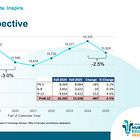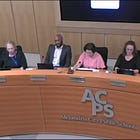Alexandria School Board weighs competing capacity needs in $340M capital budget
Board considers modulars, accelerated conversions as officials project continued capacity pressure despite enrollment decline
Alexandria City Public Schools board members debated Tuesday whether to delay a $105 million elementary school modernization to address immediate middle school overcrowding, as the district’s proposed 10-year capital budget exceeds city guidance by $54.6 million.
The $340.4 million capital improvement program includes $144.7 million in capacity projects, $5 million for leased space renovations and $190.7 million for building maintenance and infrastructure repairs.
The work session revealed uncertainty about how to balance short-term capacity needs at two overcrowded middle schools against long-term facility investments, with board members calling for closer collaboration with City Council before committing to major projects.
Board member Alexander Crider Scioscia proposed accelerating the conversions of Jefferson-Houston and Patrick Henry from K-8 to their final grade configurations while postponing the Cora Kelly modernization, arguing the city has made clear it won’t have debt capacity to fund new schools for the next decade.
“The city has made it very clear that for the next 10 years, they simply will not have the debt capacity to build us any new school,” Scioscia said.
Four scenarios present stark trade-offs
Superintendent Melanie Kay-Wyatt’s proposed plan includes a $105 million modernization of Cora Kelly Elementary School, conversion of Jefferson-Houston from a K-8 to an 850-student middle school for $30.2 million, and conversion of Patrick Henry from K-8 to K-5 elementary for $9.5 million — totaling $144.7 million in capacity projects.
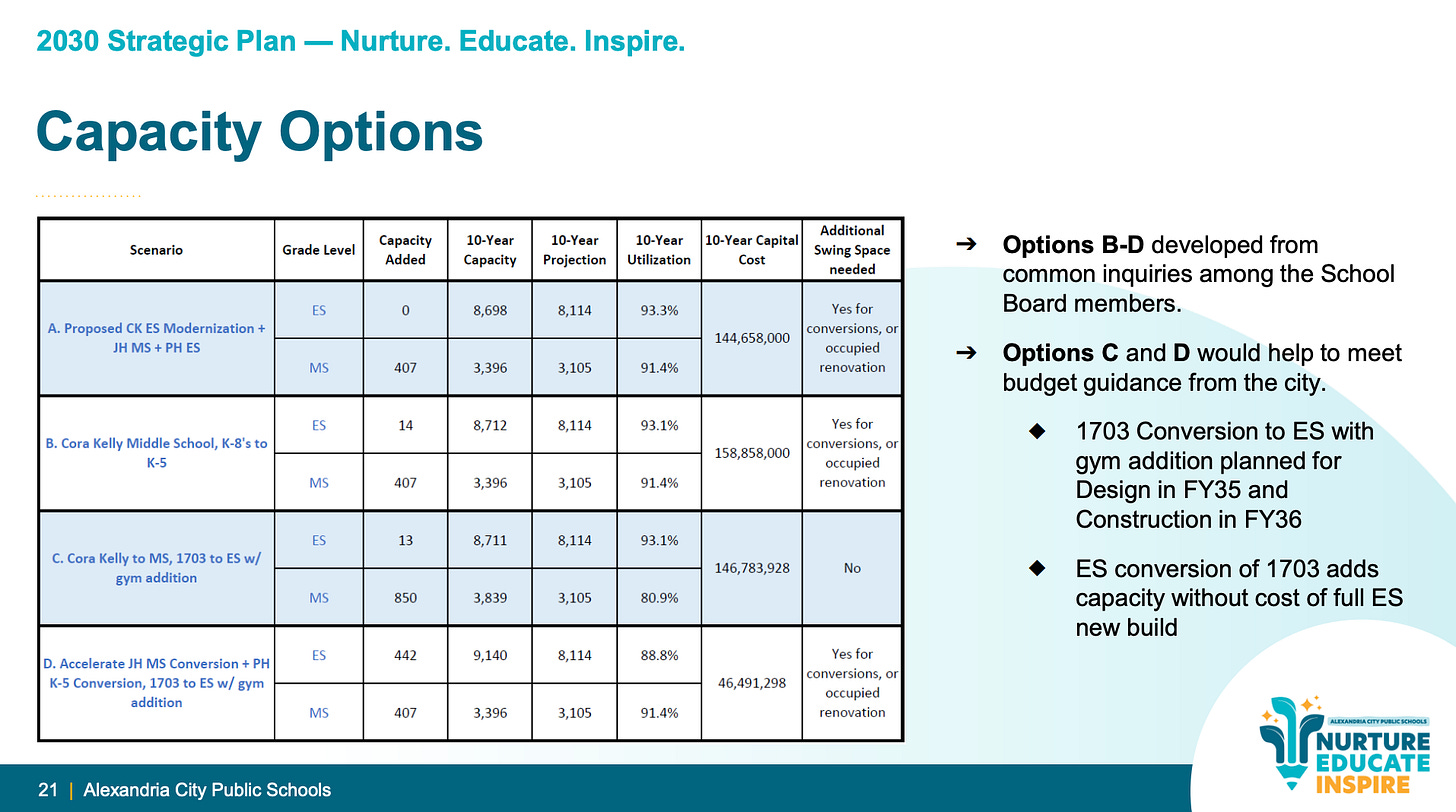
Staff also presented three alternative scenarios, including one that would cost $46.9 million by canceling the Cora Kelly project entirely and accelerating the Jefferson-Houston and Patrick Henry conversions while converting the swing space building at 1703 N. Beauregard to an elementary school.
That option, labeled Scenario D, would be the only one to stay under city budget guidance and would free up approximately $98 million for other critical needs, including the transportation facility that received a “D” rating in recent facility condition assessments.
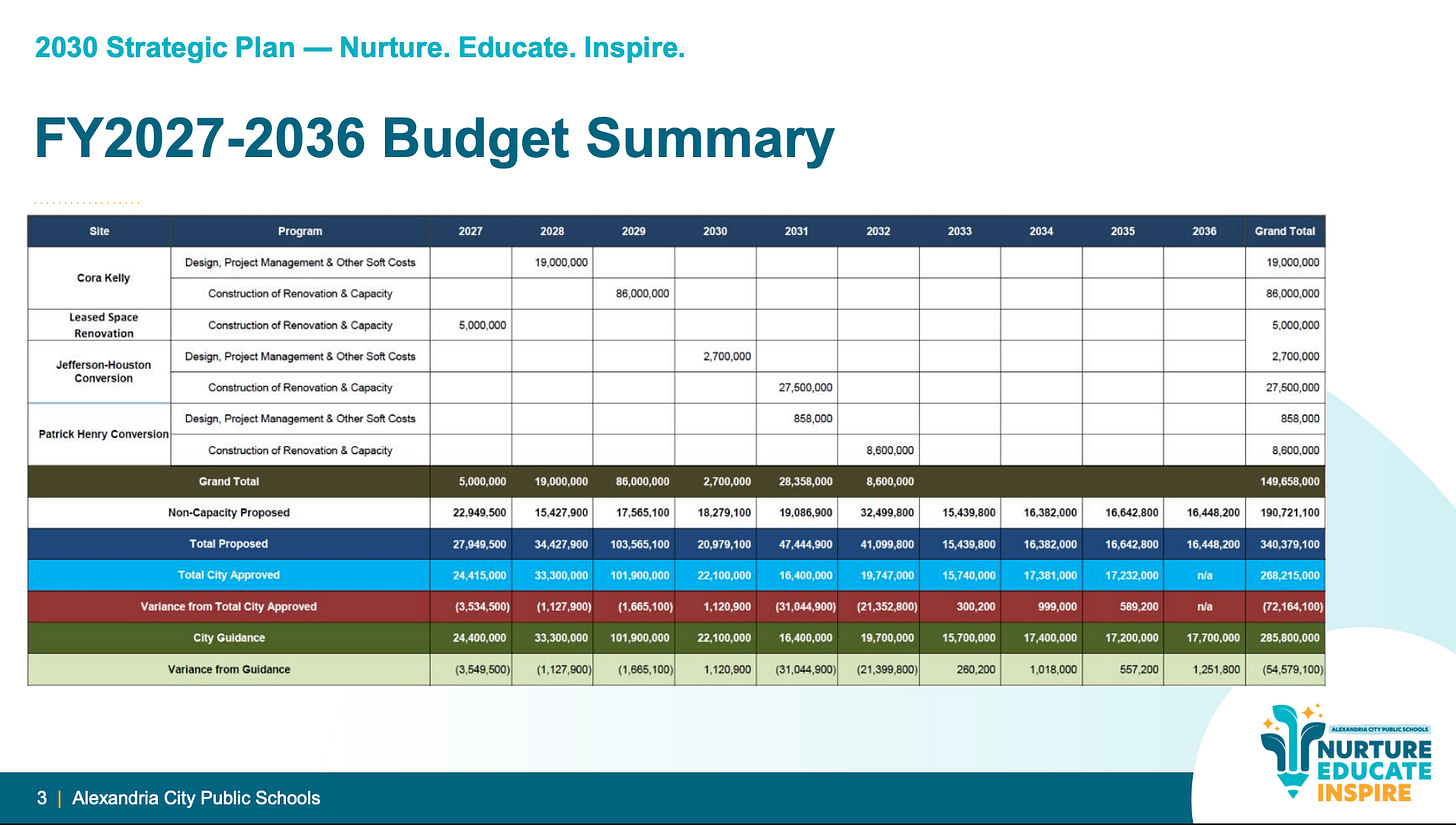
Board member Donna Kenley expressed frustration that the transportation facility — the district’s worst-rated building — receives minimal funding in the proposed budget.
“I’m disappointed and concerned that we don’t have anything really in the budget other than band-aid fixes for the transportation hub,” Kenley said.
Middle schools at 113% and 126% capacity
The district faces an immediate capacity crisis at both middle schools, with Francis C. Hammond at 113% utilization and George Washington at 126% utilization, well above the district’s target range of 90-110%.

Enrollment projections show middle school numbers peaking at 3,515 students in fiscal 2031 before declining to 3,105 by fiscal 2036 — just 116 students above current capacity of 2,989 seats.
Board member Abdulahi Abdalla questioned the logic of investing in permanent middle school capacity that won’t be ready until the enrollment peak has already passed.
“The thing I keep coming back to is let’s just say for example Mr. Beatty wins the lottery tomorrow, he donates $50 million, we can get all this going, we have the project even funded,” Abdalla said. “It won’t even be ready until our projection for middle school starts to taper out in the later years. So the use for the new middle school kind of starts to go away as we get into the later years.”
Modular classrooms face budget and timing constraints
Staff recommended installing 16 modular units — eight at each middle school — to provide 443 additional seats at a cost of $12.7-15.9 million. The temporary classrooms would require 9-12 months for procurement and installation and should be used for a maximum of five years, according to Sophie Huemer, director of capital programs, planning and design.
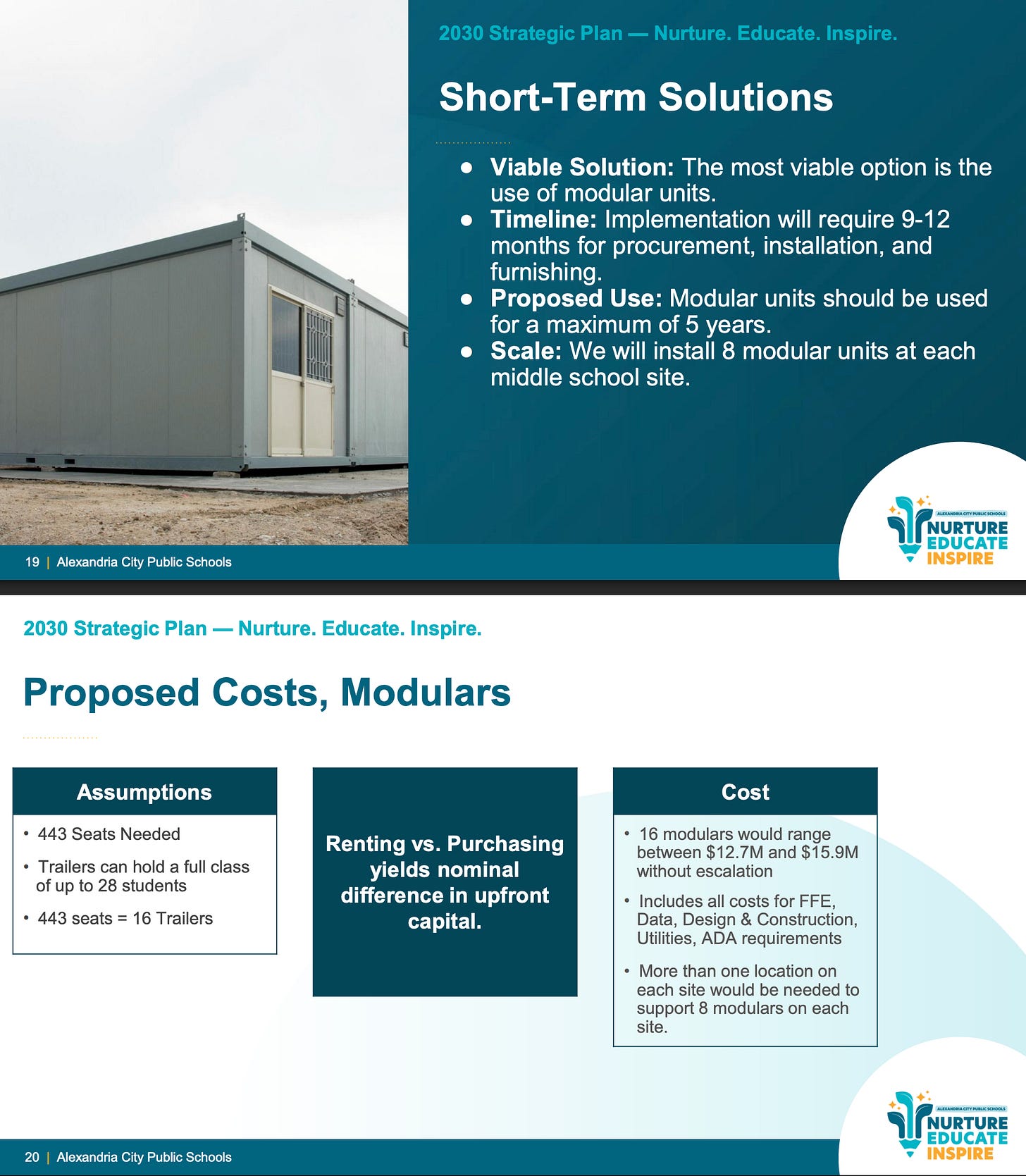
Board member Ryan Reyna cautioned that adding modulars in fiscal 2027 would require eliminating all building maintenance and HVAC projects for an entire year and would still exceed city budget guidance for that year by $3.5 million.
“It becomes, it’s not as simple as, yes, we need more space for middle school and let’s just put some modulars in because that then means, no, we are not doing any upgrades to any other building for an entire year,” Reyna said. “I just want to make sure that the community and my colleagues understand that it is not as simple as we can do all of these things.”
Board member Tim Beatty questioned whether reducing the scope of the Cora Kelly modernization — building it to current capacity rather than expanding it — could free up $15 million for modulars.
“If we weren’t going to make Cora Kelly that much bigger than it is right now, as far as number of seats, it might be less than 105 million,” Beatty said. “Could it be 90 million instead of 105 million?”
The earliest modulars could be ready is the 2027-28 school year, meaning the district must manage overcrowding for at least two more years regardless of which option is chosen.
Enrollment decline complicates planning
The discussion occurred against the backdrop of an unexpected 2.5% enrollment decline this year, with the district serving 15,928 students compared to 16,335 in fall 2024 — 617 fewer students than staff had projected.

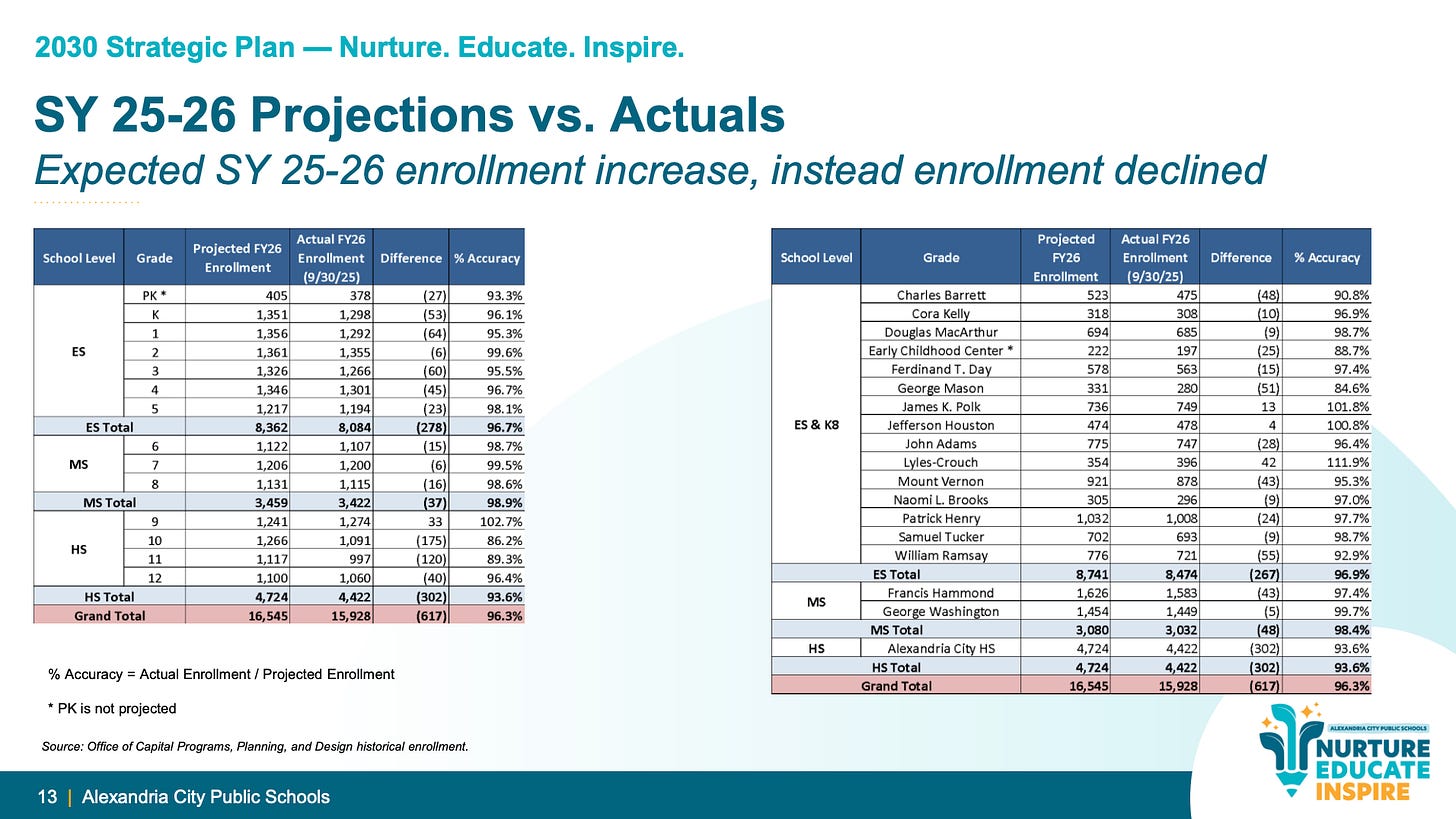
“The last time that happened was Covid,” Huemer said, referring to the 617-student gap between projections and actual enrollment.
Roberto Ruiz, principal planner, attributed the decline to possible changes in federal immigration policy and shrinking of the federal workforce affecting local families. He noted similar enrollment drops occurred across the region, with Fairfax County down 3,000 students, Montgomery County down 2,600, Loudoun County down 1,000 and Arlington County down 300.
Board member Kelly Carmichael Booz expressed concern about relying on projections showing declining middle school enrollment in later years, noting that accuracy decreases significantly beyond five years.
“My big fear is that that may not happen and that if we’re projecting at 93% [accuracy] and we actually under projected, we’re going to be in a pickle years out if we haven’t worked on the middle school capacity needs,” Booz said.
Ruiz noted that the district’s projections typically achieve 99% accuracy in the first three years and 93-96% accuracy in years five through 10.
“Most districts don’t look as far out as we do for 10 years,” Huemer said, emphasizing the importance of long-term planning despite current budget constraints.
K-8 model debate resurfaces
Board member Abdulahi Abdalla suggested reconsidering the K-8 model as an alternative to expensive conversions, citing findings from the district’s K-8 study showing the model can work with proper program implementation.
“The K-8 model does work as long as that’s one of the findings that were in the K-8 study,” Abdalla said. “One of the recommendations were to change the program side of things so it builds a strong learning vision aligned with internal policies.”
Board member Ashley Simpson Baird explained why the board decided to eliminate the K-8 model, citing staffing challenges and higher operating costs.
“The real educational program in K to 8 is a continuous program from kindergarten through eighth grade,” Simpson Baird said. “But that is very difficult [to] staff, because to do that appropriately, you need staff who have licensure that sort of cuts across both elementary and middle school, which is very difficult to find.”
Board seeks city council collaboration
Multiple board members emphasized the need for closer partnership with City Council before making final capital budget decisions.
Board Chair Michelle Rief said her biggest takeaway from monthly meetings with the mayor is to “stay within the guidance,” acknowledging that implementing modulars would likely require delaying the Cora Kelly modernization.
“I heard the feedback about wanting to have more dialogue with council, which I certainly welcome that,” Rief said. “So the modulars, I mean, if we were seriously considering modulars like that, I think the only way we could accomplish that is by pushing Cora Kelly back maybe even a year or so.”
Board member Christopher Harris called for deeper collaboration before finalizing the capital plan.
“We don’t know, we don’t fully understand the fiscal climate within the city and we say we have money budgeted for Kelly, but are we sure it’s even going to be there?” Harris said. “I think that over the next few months, I think we really need to be deliberate and have these conversations and see what our real options are.”
Superintendent Kay-Wyatt defended the proposed budget while acknowledging unprecedented fiscal uncertainty.
“I want us to be mindful of the decisions that this team has made to put this together in previous years with what was available to them, what dollars were available, what projections were available,” Kay-Wyatt said. “I don’t think we would ever think that we’d be sitting in a climate and a fiscal constraint of where it is right now, and we don’t know where it’s going to go.”
Non-capacity needs total $190.7 million
Beyond capacity projects, the district’s proposed budget includes $190.7 million in non-capacity projects over 10 years for essential building maintenance including HVAC replacements and roof repairs.

The largest non-capacity investments include $21.7 million for Alexandria City High School’s King Street campus, $20.5 million for transportation services facilities, and $12.5 million for building system upgrades and modernization across the 10-year period.
Mount Vernon Community School needs $3.4 million in fiscal 2027 for fan coil unit replacements, while James K. Polk Elementary requires approximately $12.2 million over several years for roofing and HVAC work.
Other significant projects include $11.9 million for system-wide improvements, $7.8 million for John Adams Elementary, $4.9 million for Samuel Tucker Elementary, and $3.9 million for Ferdinand T. Day Elementary.
The district also faces uncertainty from major residential developments expected to bring more than 1,000 new housing units online by 2029. Housing developments including Sanse & Naja Buildings 1A and 1B are projected to generate 250 students combined, while Samuel Madden North and South buildings could bring 226 students.
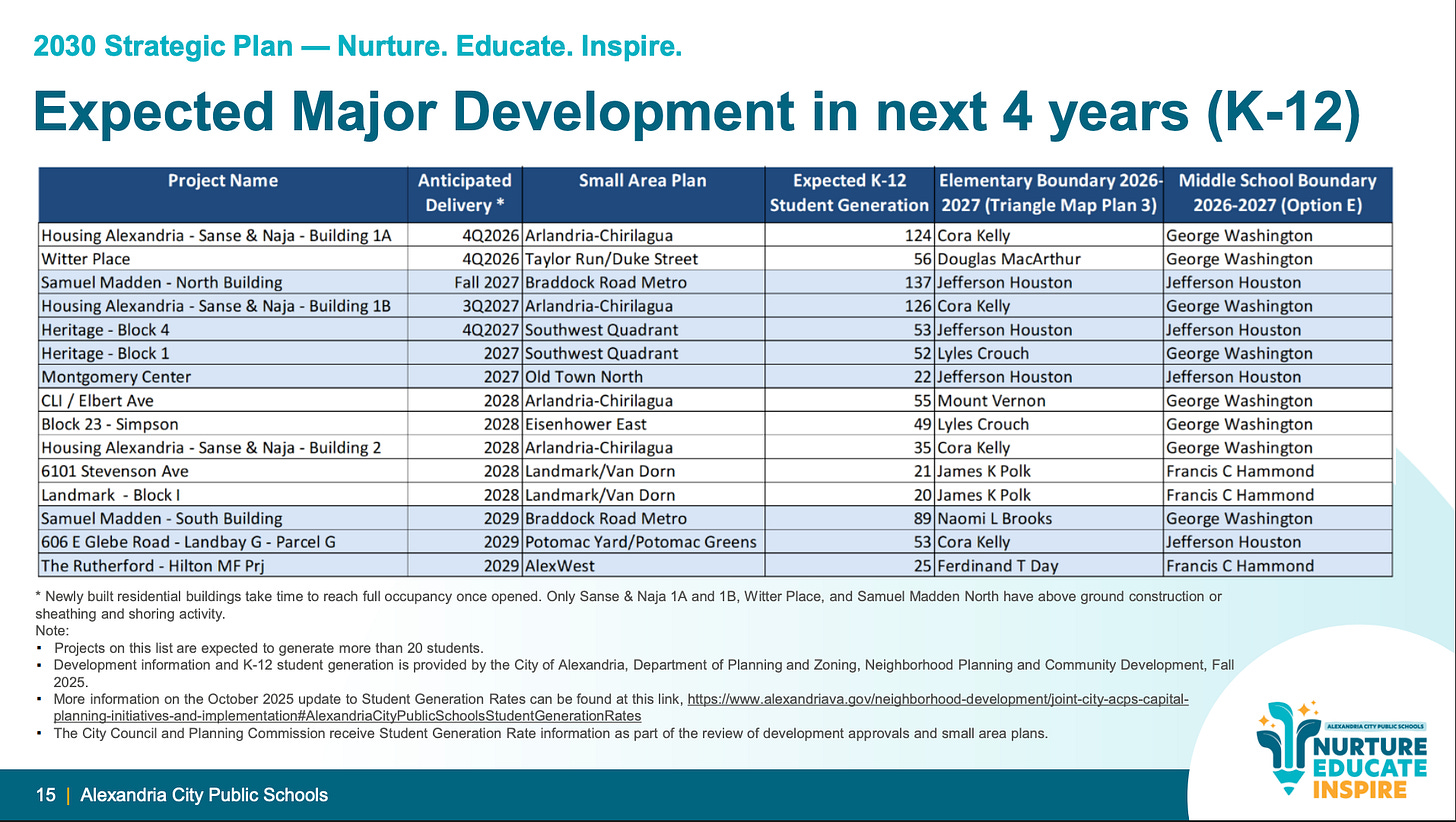
The largest individual project, Samuel Madden North Building expected in fall 2027, is projected to bring 137 students to Jefferson-Houston Elementary. Other significant developments include Sanse & Naja Building 1A (124 students to Cora Kelly) and Building 1B (126 students to Cora Kelly), both expected in the fourth quarter of 2026.
However, student enrollment from these developments isn’t yet incorporated into district forecasts pending further coordination with city planning departments.
Next steps
The board will continue discussions during add-delete sessions in December, with member requests due next Tuesday at noon. Staff will provide written responses to board questions by this Friday.
The final capital budget requires City Council approval, though the council only funds one year at a time despite the 10-year planning horizon. There will be a joint subcommittee meeting with City Council on Nov. 24.
The board will host CIP Add/Delete Work Sessions on December 11 and December 16, and is scheduled to adopt its capital budget on December 18 before submitting it to the city for review and approval.
The three-hour work session ended just before 9 p.m. Tuesday.


